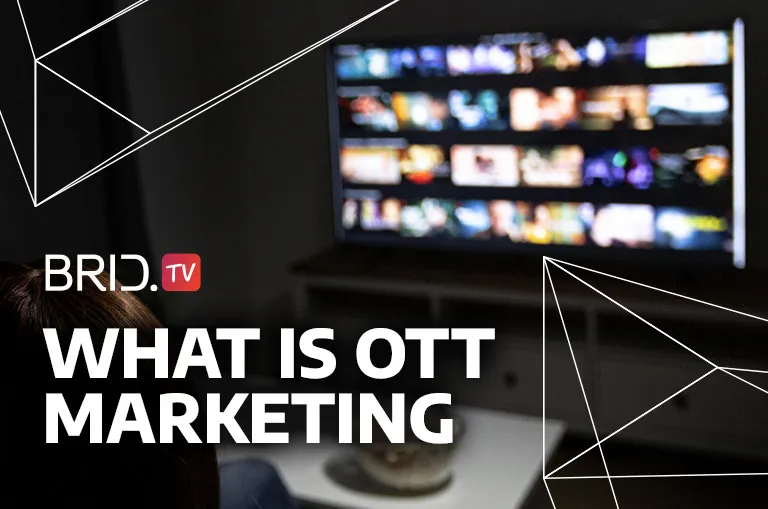The OTT industry has been booming lately as more and more users are replacing traditional cable and satellite TV in favor of various streaming services. This trend has been so prevalent that analysts predict there are over 50 million cord-cutters in 2021 in the U.S. alone. And since the consumers changed their viewing habits, advertisers had to follow suit. That is where OTT marketing proved to be the best option.
Between 2020 and 2021, the viewership of OTT TV content increased by a whopping 115%. The primary reason behind this rise in OTT consumption was partly due to the COVID-19 pandemic that forced many people worldwide to become homebound. However, widespread cord cutting has been prevalent long before that; the pandemic just sped up the process.
The inevitable rise of OTT marketing brought a lot to both advertisers and publishers. Publishers got access to easy OTT monetization at high CPM rates, while the advertisers enjoyed benefits like greater ad viewability than in web advertising, massive reach, and no additional ad slot fees like in traditional TV advertising.
In this article, we’re going to take a detailed look into the world of OTT marketing, what it brings to the table for advertisers and publishers, and the current state of the market. So whether you’re an advertiser looking for a way to expand your business or an aspiring OTT content provider exploring your options, here’s why OTT marketing is likely the right choice for you.
What Is OTT Marketing
OTT marketing entails advertising your brand over the internet on various OTT streaming services. Unlike traditional TV advertising, OTT marketing is a much broader term that encompasses all OTT streaming devices, not just TVs. Here are just a few platforms you can use to access OTT content:
- Smart TVs
- OTT Boxes (e.g., Roku, Chromecast, Apple TV)
- Desktop and Mobile Devices
- Gaming Consoles (e.g., Playstation 5, Xbox Series X)
Aside from reaching broader audiences across multiple devices, OTT marketing is superior to traditional advertising since it enables brands to serve several types of ads (e.g., instream video ads, banner ads). The technology also lets advertisers bypass the fees and restrictions of traditional TV providers, giving them more control over their ad distribution and targeting.
Why Brands Are Investing in OTT Marketing
With the popularity of OTT broadcasting services like Netflix and Disney+ exploding worldwide, many brands quickly took advantage of this opportunity. Advertising on such a young and untapped market proved ideal for getting brands in front of vast audiences at low prices. OTT marketing lets advertisers reach their target audiences for a fraction of the cost they’d have to spend on TV commercials while also offering many other benefits.
Here are a few of the most notable reasons brands are investing in OTT marketing so eagerly:

1. It Allows Them to Reach Cord Cutters
Nearly 30% of U.S. consumers are planning to cut the cord in 2021. When you combine that with the cord-cutting stats we mentioned before, it becomes clear how few people watch traditional TV nowadays.
By leveraging OTT advertising, brands can reach millions of people they otherwise wouldn’t be able to with cable or satellite TV. That is particularly true for younger audiences.
Although there is still substantial TV viewership worldwide, a study found that nearly 90% of younger people prefer accessing TV content through the internet. That makes OTT marketing one of the best ways to reach this demographic.
So should it be surprising why so many brands choose to market themselves on OTT? We don’t think so!
You Might Also Like: Best OTT Apps to Watch Your Favorite Shows On
2. It’s Omnichannel
Another massive benefit of OTT over traditional TV marketing is that OTT content is not limited to TV. That’s right — viewers can consume OTT content on various devices.
Since OTT content is delivered over the internet, any device with internet access and the ability to play videos is OTT-compatible. Whether you wish to watch your favorite show on the go over your mobile device or want to access your favorite OTT app over your gaming console, you can do that without much hassle.
This unprecedented accessibility is why OTT marketing boomed so much over the last few years and is the primary reason brands are turning toward it en masse. All seasoned brands realize the value omnichannel marketing brings to the table. That is especially true now when most people prefer to have flexibility on how and where they consume content.
You Might Also Like: OTT vs. CTV — All the Differences Explained
3. OTT Ads Have Better Viewability
One of the most significant advantages for advertisers of OTT marketing over video advertising on the web is higher ad viewability. But what does that mean?
It’s pretty straightforward — most websites are overcrowded with banners, pop-ups, and video ads. These can be incredibly intrusive and irritating for the user. But even if they aren’t, it’s challenging to make your ad stick out when it’s just one of several on an already modestly sized screen. Even instream video ads on video-sharing sites like YouTube rarely go without an accompanying banner or overlay ad. As you can imagine, these scenarios are not ideal for advertisers.
Unlike in the above scenarios, OTT advertising ensures better ad viewability as OTT instream ads appear alone. That guarantees your brand will always be in the spotlight. And since most consumers watch on-demand content on their TVs, most of these ads play on large screens and at a higher volume than on the web. That means these ads make much better impressions on the viewers, leading to better brand recall rates.
4. There Are No Ad Blockers in OTT
Ad blockers have been plaguing advertisers and publishers online for years now. As of 2021, around 27% of Americans block ads when browsing the web. That translates into more than a quarter of potential ad revenue lost for publishers and potential customers for advertisers.
In a world where ad blockers are running rampant, OTT marketing came as the perfect solution. Blocking ads on OTT apps is nigh impossible yet, so publishers and advertisers can rest easy knowing they won’t be losing any revenue and impressions to ad blockers.
You Might Also Like: A Comparison of 12 Best OTT Platforms for Launching an OTT Business
Is It Worth Investing in the OTT Market in 2021?
The benefits of investing in OTT marketing are there, but what’s the state of the OTT industry currently? Is there still room to enter the market and invest in it?
Absolutely! Since the OTT industry is still young, there are plenty of opportunities to enter the market and make a name for your brand. So even if you think you’re late to the race, don’t be. The growth potential of the market is immense.
According to the latest Allied Market Research study, the global OTT market was worth around $121 billion in 2019. However, that number is estimated to grow to over $1,000 billion by 2027! That should be a clear indicator of how much potential the market has.
But when we talk about the market’s potential for advertisers, saying that it’s massive would be an understatement. Although the two most common monetization models (AVOD and SVOD) have about equal representation in the market, the advertising-based model brings more revenue (51.8% of total market revenue). And experts predict that more and more publishers will begin adopting this or the hybrid model, meaning advertisers will always have a place to promote their products.

So whether you are a publisher or an advertiser, there is much to gain from giving OTT a shot. Publishers can enter a relatively fresh market with access to broad audiences and lucrative video monetization options. Alternatively, advertisers can reach consumers they couldn’t via traditional TV while enjoying excellent ad viewability. Either way, it’s a winning scenario for both parties.


